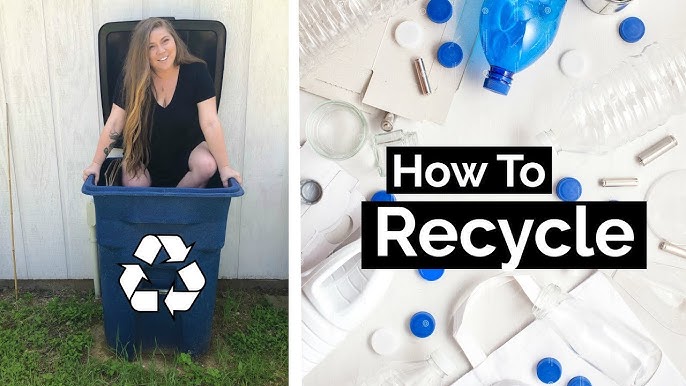How to Recycle Properly: A Comprehensive Guide

Recycling is an essential part of sustainable living. It helps reduce waste, conserve natural resources, and minimize our environmental impact. However, recycling can be more complex than simply tossing items into a bin. Proper recycling involves understanding what can and cannot be recycled, how to prepare materials, and adhering to local recycling guidelines. This comprehensive guide will provide you with everything you need to know about recycling properly.
The Importance of Recycling
Environmental Benefits
- Reduces Waste in Landfills: Recycling diverts waste from landfills, reducing the amount of space required for waste disposal.
- Conserves Natural Resources: By recycling materials like paper, plastic, and metals, we conserve natural resources such as trees, water, and minerals.
- Saves Energy: Manufacturing products from recycled materials often requires less energy than producing them from raw materials. For example, recycling aluminum saves up to 95% of the energy needed to produce new aluminum.
- Reduces Pollution: Recycling reduces the need for raw material extraction, which can cause air and water pollution. It also reduces greenhouse gas emissions.
Economic Benefits
- Creates Jobs: The recycling industry creates jobs in collection, processing, and manufacturing.
- Saves Money: Proper recycling can reduce waste disposal costs for individuals, businesses, and municipalities.
Social Benefits
- Promotes Environmental Awareness: Recycling encourages individuals and communities to be more conscious of their consumption and waste production.
- Fosters Community Engagement: Recycling programs can bring communities together through local initiatives and education efforts.
Understanding What Can Be Recycled
Commonly Recycled Materials
- Paper and Cardboard:
- Newspapers
- Magazines
- Office paper
- Cardboard boxes
- Paper bags
- Glass:
- Bottles (e.g., soda, wine, beer)
- Jars (e.g., food containers)
- Plastic:
- Bottles (e.g., water, soda, milk)
- Containers (e.g., yogurt, margarine)
- Bags (e.g., grocery, produce)
- Packaging (e.g., blister packs, plastic wrap)
- Metals:
- Aluminum cans (e.g., soda, beer)
- Steel cans (e.g., food containers)
- Foil (e.g., aluminum foil, trays)
- Electronics:
- Computers
- Mobile phones
- Batteries
- Appliances (e.g., refrigerators, microwaves)
Items That Often Cannot Be Recycled
- Food-Contaminated Items:
- Greasy pizza boxes
- Food wrappers with residue
- Certain Plastics:
- Plastic bags (unless specified by your local recycling program)
- Styrofoam (unless specified by your local recycling program)
- Hazardous Materials:
- Paints
- Chemicals
- Medical waste
- Mixed Materials:
- Items made of multiple materials that are difficult to separate (e.g., some toys, electronics without proper disposal programs)
- Other Non-Recyclable Items:
- Ceramics
- Light bulbs (some may require special recycling)
- Mirrors
- Non-recyclable plastics (e.g., certain types of plastic film)
Preparing Materials for Recycling
Paper and Cardboard
- Remove Contaminants: Ensure paper and cardboard are free from food residue, grease, and other contaminants.
- Flatten Boxes: Flatten cardboard boxes to save space and make transportation easier.
- Separate Types: Separate different types of paper (e.g., office paper, newspapers) if required by your local recycling program.
Glass
- Rinse Containers: Rinse glass bottles and jars to remove food and liquid residue.
- Remove Lids: Remove metal or plastic lids and place them in the appropriate recycling bins.
- Avoid Breakage: Handle glass carefully to avoid breakage. Broken glass may not be accepted by some recycling programs.
Plastic
- Rinse Containers: Rinse plastic containers to remove food and liquid residue.
- Check Labels: Check for recycling symbols and numbers on plastic items to ensure they are accepted by your local recycling program.
- Remove Caps: Remove caps from plastic bottles and containers. Some programs recycle caps separately.
Metals
- Rinse Cans: Rinse aluminum and steel cans to remove food and liquid residue.
- Remove Labels: Remove paper labels from cans if required by your local recycling program.
- Flatten Cans: Flatten cans to save space if required by your local recycling program.
Electronics
- Data Wiping: Wipe all personal data from electronic devices before recycling.
- Separate Components: Separate batteries and accessories from the main device.
- Follow Guidelines: Follow specific guidelines provided by your local e-waste recycling program.
Local Recycling Guidelines
Researching Local Guidelines
- Municipal Websites: Visit your local municipality’s website for information on recycling guidelines and accepted materials.
- Recycling Centers: Contact local recycling centers for detailed information on their processes and requirements.
- Waste Management Companies: If you use a private waste management company, check their guidelines for recycling.
Common Local Guidelines
- Single-Stream Recycling: All recyclables are placed in a single bin and sorted at the recycling facility.
- Dual-Stream Recycling: Recyclables are separated into two categories (e.g., paper and containers) and placed in separate bins.
- Drop-Off Centers: Some areas have drop-off centers where you can bring sorted recyclables.
- Curbside Pickup: Many municipalities offer curbside pickup services for recyclables. Check the schedule and guidelines for your area.
Tips for Effective Recycling
Reduce and Reuse
- Reduce Consumption: Be mindful of your consumption and choose products with minimal packaging.
- Reuse Items: Reuse items whenever possible, such as using reusable bags, containers, and water bottles.
- Donate: Donate items that are still usable, such as clothing, furniture, and electronics.
Proper Sorting
- Know What’s Recyclable: Familiarize yourself with what can and cannot be recycled in your area.
- Label Bins: Label recycling bins clearly to help household members sort items correctly.
- Stay Updated: Stay informed about changes in local recycling guidelines and practices.
Educate Others
- Share Knowledge: Share your knowledge about proper recycling with family, friends, and neighbors.
- Lead by Example: Demonstrate good recycling habits to encourage others to follow suit.
- Community Involvement: Participate in or organize community recycling initiatives and events.
Common Recycling Mistakes to Avoid
Contaminating Recyclables
- Dirty Containers: Ensure all containers are clean and free from food residue.
- Non-Recyclable Items: Do not place non-recyclable items in the recycling bin.
Incorrect Sorting
- Mixed Materials: Avoid placing items made of multiple materials that are difficult to separate.
- Plastic Bags: Do not place plastic bags in the recycling bin unless specified by your local program.
Overloading Bins
- Overfilled Bins: Do not overfill recycling bins, as this can make collection difficult.
- Unsorted Items: Avoid placing unsorted items in the recycling bin.
Special Recycling Programs
Hazardous Waste
- Household Chemicals: Many communities have special programs for household chemicals, such as paint, cleaners, and pesticides.
- Electronic Waste: Some electronics, such as batteries and certain appliances, require special recycling programs.
- Medical Waste: Medical waste, such as needles and medications, should be disposed of through specialized programs.
Composting
- Organic Waste: Composting is an excellent way to recycle organic waste, such as food scraps and yard waste.
- Composting Programs: Many communities offer composting programs or facilities.
Deposit-Return Programs
- Bottle Deposits: Some areas have deposit-return programs for beverage containers. Return these containers to collection points to reclaim your deposit.
Advanced Recycling Techniques
Upcycling
- Creative Reuse: Upcycling involves creatively reusing materials to create new products. Examples include turning old clothing into rags or using glass jars for storage.
- DIY Projects: Engage in DIY projects that repurpose items you would otherwise discard.
Industrial Recycling
- Specialized Facilities: Certain materials, such as construction debris or industrial waste, require specialized recycling facilities.
- Collaboration: Businesses can collaborate with recycling companies to ensure proper disposal and recycling of industrial waste.
Zero Waste Initiatives
- Waste Reduction Goals: Zero waste initiatives aim to reduce the amount of waste sent to landfills to zero. This involves reducing consumption, reusing items, and recycling as much as possible.
- Community Programs: Participate in or support community zero waste programs and initiatives.
Conclusion
Proper recycling is a crucial component of sustainable living. By understanding what can be recycled, preparing materials correctly, and following local guidelines, you can contribute to a healthier environment. Remember to reduce, reuse, and educate others about the importance of recycling. Together, we can make a significant impact on the planet’s health and well-being.







